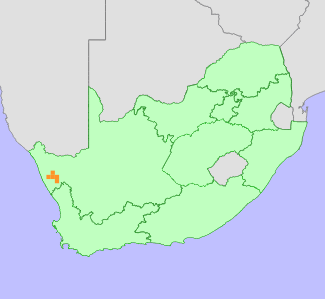|
Scientific Name | Haemanthus graniticus Snijman |
Higher Classification | Monocotyledons |
Family | AMARYLLIDACEAE |
National Status |
Status and Criteria | Endangered B1ab(iii,v)+2ab(iii,v); C2a(i) |
Assessment Date | 2022/02/01 |
Assessor(s) | D.A. Snijman, N.N. Mhlongo & N.A. Helme |
Justification | This species has a limited distribution range with an area of occupancy (AOO) of 32 km² and an extent of occurrence (EOO) of 802 km². It is known from between four and six locations. The subpopulations are small, with typically less than 50 plants per subpopulation, and the overall population numbers are fewer than 1000 mature individuals. At least 13% of this species' habitat has been lost in the past due to ploughing for crops and illegal collecting for the horticultural trade has resulted in further declines to the population. It therefore qualifies for listing as Endangered under criteria B and C. |
Distribution |
Endemism | South African endemic |
Provincial distribution | Northern Cape |
Range | It has a restricted distribution in the Northern Cape Province of South Africa, where it occurs from Springbok to Kamiesberg. |
Habitat and Ecology |
Major system | Terrestrial |
Major habitats | Namaqualand Granite Renosterveld |
Description | Plants grow near seasonal watercourses in coarse, granite-derived soils. |
Threats |
| This species is threatened by habitat degradation as a result of ploughing, particularly for the Kamiesberg subpopulations. It is also threatened by illegal collection. |
Population |
The population is estimated to be less than 1000 plants, with fewer than 10 plants typically seen per subpopulation and no subpopulation recorded to have more than 50 mature individuals. However, this species is quite inconspicuous and may be under-recorded. Populations consist of clumps of bulbs scattered along seasonal watercourses. In Kamiesberg, along the streams, less than 50 individuals were reported, and four plants were reported in Grootvlei. The population is inferred to be declining as a result of illegal collection and ongoing habitat degradation.
|
Population trend | Decreasing |
Conservation |
| It is not formally protected. |
Assessment History |
Taxon assessed |
Status and Criteria |
Citation/Red List version | | Haemanthus graniticus Snijman | EN B1ab(i,ii,iii,v) | Raimondo et al. (2009) | | Haemanthus graniticus Snijman | VU B1B2abc | Victor (2002) | | Haemanthus graniticus Snijman | Rare | Hilton-Taylor (1996) | |
Bibliography |
Hilton-Taylor, C. 1996. Red data list of southern African plants. Strelitzia 4. South African National Botanical Institute, Pretoria.
Hilton-Taylor, C. Unpublished. Succulent Karoo Red Data List (version 1997 - in preparation). SANBI.
Raimondo, D., von Staden, L., Foden, W., Victor, J.E., Helme, N.A., Turner, R.C., Kamundi, D.A. and Manyama, P.A. 2009. Red List of South African Plants. Strelitzia 25. South African National Biodiversity Institute, Pretoria.
Snijman, D.A. 1982. Notes on Haemanthus L.: the identity of Haemanthus amarylloides Jacq. Journal of South African Botany 48(1):93-103.
Snijman, D.A. 1984. A revision of the genus Haemanthus L. (Amaryllidaceae). Journal of South African Botany Supplement 12:1-139.
Snijman, D.A. 2013. Plants of the Greater Cape Floristic Region 2: The extra Cape flora. Strelitzia 30. South African National Biodiversity Institute, Pretoria.
Victor, J.E. 2002. South Africa. In: J.S. Golding (ed), Southern African plant Red Data Lists. Southern African Botanical Diversity Network Report 14 (pp. 93-120), SABONET, Pretoria.
|
Citation |
| Snijman, D.A., Mhlongo, N.N. & Helme, N.A. 2022. Haemanthus graniticus Snijman. National Assessment: Red List of South African Plants version . Accessed on 2025/08/22 |
 Comment on this assessment
Comment on this assessment


